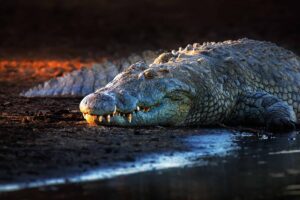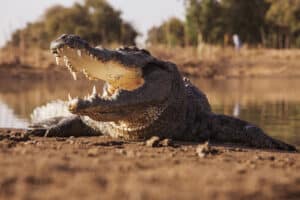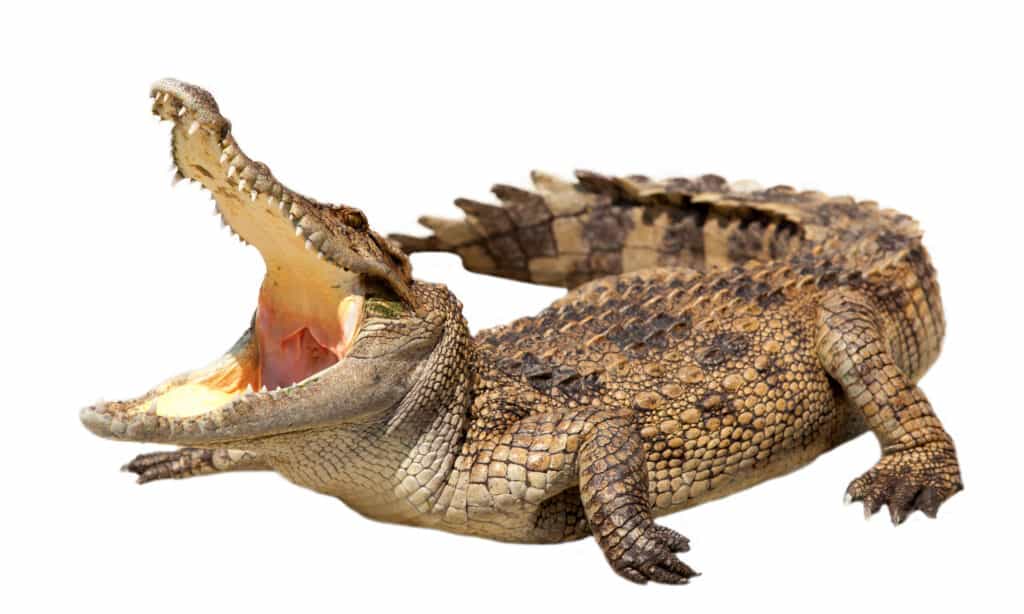
Crocodiles will often gape open their mouths for the purpose of keeping cool, since they lack sweat glands.
©iStock.com/nattanan726
Crocodiles are large and in charge when it comes to the food chain. These apex predators are opportunistic carnivores and eat just about anything that comes their way, although some are much more aggressive than others. Some crocodiles live in freshwater, while others prefer saltwater or brackish habitats. From the tropical regions of the Americas to Australia, Asia, and Africa, these living dinosaurs continue to inspire fear, respect, and admiration for their fortitude, strength, and acute senses. Killer crocs can grow over 20 feet long, while other more docile species may only reach 5 feet long in a single lifetime. Let’s take a closer look at each of the 18 types of crocodiles found across the world!
1. American crocodile (Crocodylus acutus)
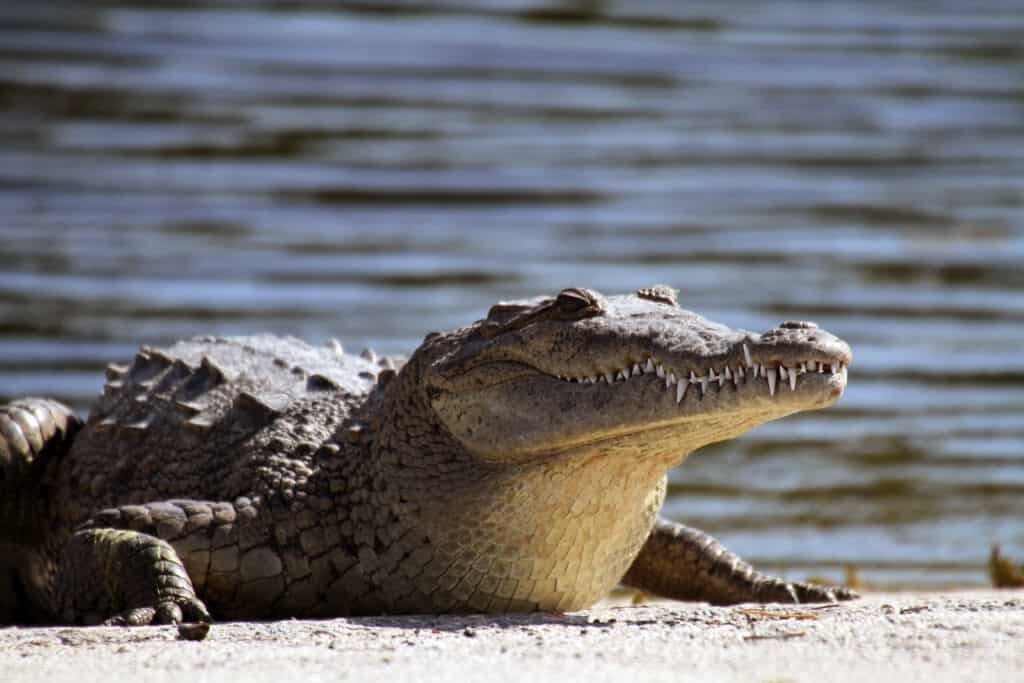
American Crocodiles can grow up to 20 feet long.
©iStock.com/GriffinGillespie
Although it may be tempting to confuse it with the American alligator, the American crocodile can be easily distinguished by its lighter color. American alligators are darker green or brownish green, while American crocodiles are a gray or grayish-green color. These massive crocs can grow up to 20 feet long. However, most do not grow longer than 14 feet at most. Even though they are large and potentially dangerous, American crocodiles are actually shy and rather reclusive animals. They even coexist with other large reptiles like American alligators and spectacled caimans. Although they are apex predators, American crocodiles are a vulnerable species due to habitat loss and degraded water conditions.
American crocodiles live in South Florida, as well as throughout many of the Caribbean islands and the Caribbean Basin. They are one of the few crocodile species that swim out to sea, which is how they have been able to become so widely distributed across the Caribbean. American crocodiles have been seen from south Florida’s coasts to Cuba, Hispaniola, and Jamaica, as well as the coasts of Central America and southern Mexico. They can live in rivers, although they prefer saltier waters like brackish lagoons, coasts, lakes, and mangrove swamps. In fact, American crocodiles are one of only two species of crocodile that frequently live in saltwater habitats.
2. New Guinea Crocodile (Crocodylus novaeguineae)
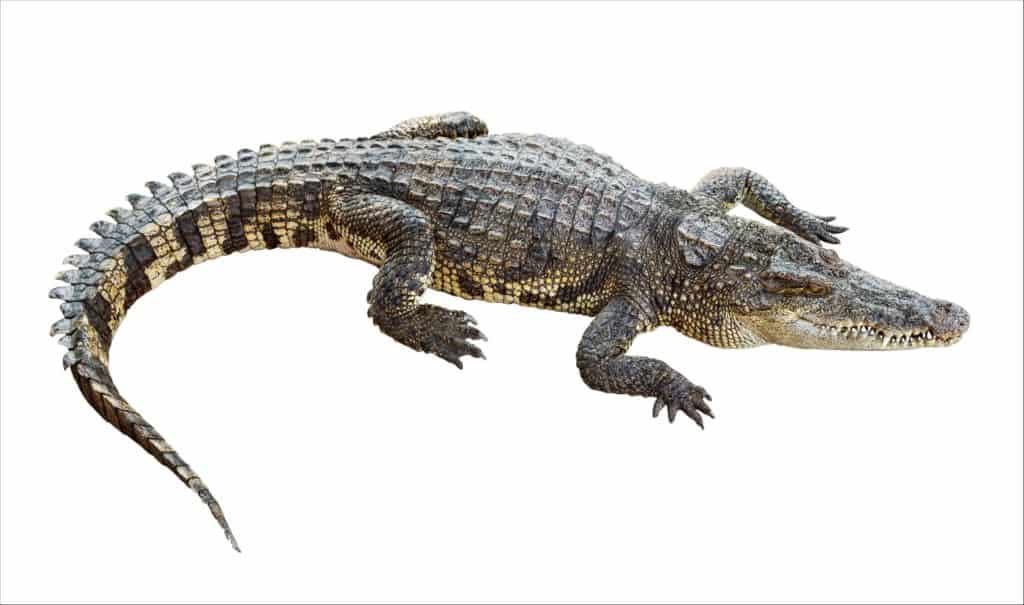
The New Guinea crocodile hails from the Island of New Guinea, but only in the island’s northern regions.
©iStock.com/Samohin
Technically scientists consider the New Guinea crocodile a “smaller” species, but they certainly are not the smallest. Males can grow up to 11 feet long and weigh up to 650 pounds! On the other hand, females are slightly smaller with a stockier build, growing up to 9 feet long. So definitely not a “tiny” crocodile, but not one of the biggest ones out there. New Guinea crocodiles are typically a gray or brownish-gray color with dark markings on their tails. Young crocs have narrow, V-shaped snouts that widen as they age.
The New Guinea crocodile hails from the Island of New Guinea, but only in the island’s northern regions. These island crocodiles prefer freshwater areas like marshes, swamps, and lakes but can also tolerate brackish water. During the 20th century, they were hunted and prized for their skin. Fortunately, conservation efforts have helped to protect the species. Despite its small territory, it is now listed as “Least Concern” by the International Union for Conservation of Nature (IUCN). These impressive crocodiles mainly hunt at night, eating fish, crabs, frogs, shrimp, snakes, birds, and anything else they can find.
3. Hall’s New Guinea Crocodile (Crocodylus halli)
A large mountain range splits the island of New Guinea so that both the island’s north and south sides have their own distinct habitats. While the New Guinea crocodile lives in the northern regions, Hall’s New Guinea crocodile lives on the island’s southern portion. Hall’s New Guinea crocodile looks much like its northern cousin, but analyses of its skull and genetics show that it is its own separate species.
However, it was not until 2020 that scientists knew that Hall’s New Guinea crocodile was truly a separate species. The croc is named after Philip Hall, a herpetologist who long suspected that there were, in fact, two separate crocodile species in New Guinea back in the 1990s before studies could officially prove it.
4. Freshwater Crocodile (Crocodylus johnstoni)

Freshwater crocodiles mainly live in freshwater creeks, rivers, billabongs, and wetlands.
©kongsky/Shutterstock.com
Although some may confuse them with Australia’s saltwater crocodile, freshwater crocodiles are actually quite shy and do not typically attack humans. They may bite as a defense when threatened, but this is still pretty uncommon. Freshwater crocodiles mainly live in freshwater creeks, rivers, billabongs, and wetlands far away from the sea where they can stay away from saltwater crocodiles. While they can technically tolerate saltwater, they prefer to stay inland in freshwater habitats to avoid competition with their saltwater cousins. They commonly eat fish, amphibians, reptiles, bats, birds, and even wallabies.
This relatively small crocodile is endemic to northern Australia, where it grows between 7-9.8 feet long. Males typically weigh about 150 pounds, while females weigh 88 pounds. Their snouts and teeth are a bit smaller and more slender than those of a saltwater crocodile, and their bodies are light brown with dark-colored bands.
5. Saltwater Crocodile (Crocodylus porosus)
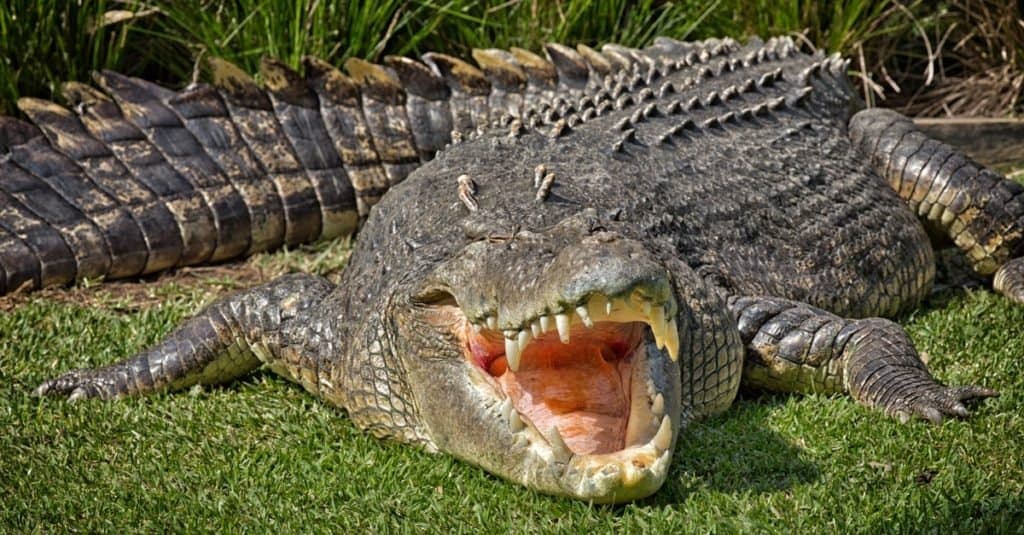
Saltwater crocodiles live in coastal waters like river deltas, mangrove swamps, estuaries, and billabongs.
©PomInOz/Shutterstock.com
One of the most well-known crocodiles in the world is the saltwater crocodile, found in northern Australia and throughout southeastern Asia. These massive crocs are the largest type of crocodiles and reptiles living on the planet! Male saltwater crocodiles usually grow between 11-19 feet long and can weigh up to 2,200 pounds. However, estimates based on skulls from deceased crocodiles suggest that on rare occasions saltwater crocodiles could possibly even grow up to 23 feet long and weigh around 4,400 pounds! You will likely never see a crocodile quite that big though, due to overhunting and poaching of these massive animals.
Saltwater crocodiles live in coastal waters like river deltas, mangrove swamps, estuaries, and billabongs. These great reptiles can travel surprisingly far – even across the ocean! They use ocean currents to propel their bodies across long distances of open ocean, sometimes for weeks at a time and traveling hundreds of miles. They are typically slow and lethargic, although when necessary, a saltwater crocodile can spring through the water at 15 mph. These are not creatures that you want to mess with. They are extremely territorial and have one of the strongest bite forces of any animal on earth. Saltwater crocodiles are the famous crocs from the Australian Zoo, made famous by the late Crocodile Hunter, Steve Irwin.
6. Borneo Crocodile (Crocodylus raninus)

Borneo crocodile was first described in 1844, although many scientists thought it was just another example of the saltwater crocodile.
©Kelsey Fox/Shutterstock.com
Living on the island of Borneo in southeastern Asia, the Borneo crocodile is an enigmatic type of crocodile that researchers still do not know much about. This crocodile was first described back in 1844, although many scientists thought it was actually just another example of the saltwater crocodile. However, it was revalidated once again in the 1990s as its own separate species. We do not really know how many of these elusive crocodiles exist in the wild, however, as the animals that have been studied were juveniles or deceased animals that came from crocodile farms or villages in Borneo.
7. Siamese Crocodile (Crocodylus siamensis)
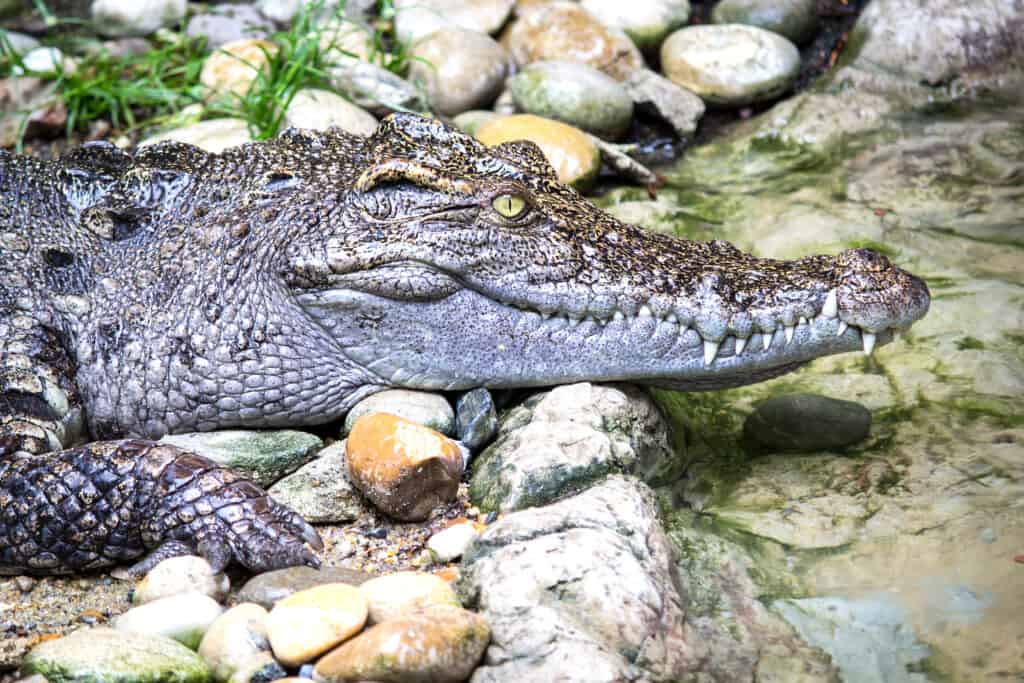
Siamese crocodiles are now extinct from nearly 99% of their original range.
©Southtownboy Studio/Shutterstock.com
The critically endangered Siamese crocodile lives in southeastern Asia. It is usually found in Brunei, Indonesia, Laos, Vietnam, Thailand, Myanmar, Cambodia, and East Malaysia. However, it is hard to say how many of these crocs are left in the wild, and in many of these regions, they may have already been extirpated. Siamese crocodiles are now extinct from nearly 99% of their original range. This is because of habitat loss and degradation, as well as exploitation and illegal capture.
These medium-sized crocodiles prefer freshwater habitats like oxbow lakes, swamplands, marshes, rivers, and streams. Siamese crocodiles are usually only around 7 feet long. However, on rare occasions, they can grow to 10 feet or more. with dark green or olive-green bodies. In general, they weigh 88-154 pounds.
8. Mugger Crocodile (Crocodylus palustris)

Although it is not the largest type of crocodile out there, the mugger crocodile has the broadest snout of any croc.
©Martin Mecnarowski/Shutterstock.com
Although it may look a lot like an alligator at first glance, the mugger crocodile is most definitely a croc! This medium-sized crocodile lives on the Indian subcontinent and many of its surrounding countries. It enjoys swimming in slow-moving freshwater ponds, rivers, lakes, marshes, irrigation canals, and artificial reservoirs. Its unusual name is a corruption of the Hindi word, “magar,” or “water monster”.
Although it is not the largest type of crocodile out there, the mugger crocodile has the broadest snout of any croc and is a surprisingly powerful swimmer. Mugger crocodiles have a somewhat alligator-like appearance, with large scutes that make them look like they are wearing heavy dark gray or brown armor. Male crocodiles usually grow 9-11.5 feet long, while females grow 6.5-8 feet long. However, on rare occasions, mugger crocodiles can grow up to 16.5 feet long. Interestingly, both male and female mugger crocodiles protect their babies for up to an entire year as they grow and mature. Mugger crocodiles typically eat fish, birds, reptiles, and mammals – although one unique croc in India is famous for her allegedly vegetarian diet!
9. Philippine Crocodile (Crocodylus mindorensis)
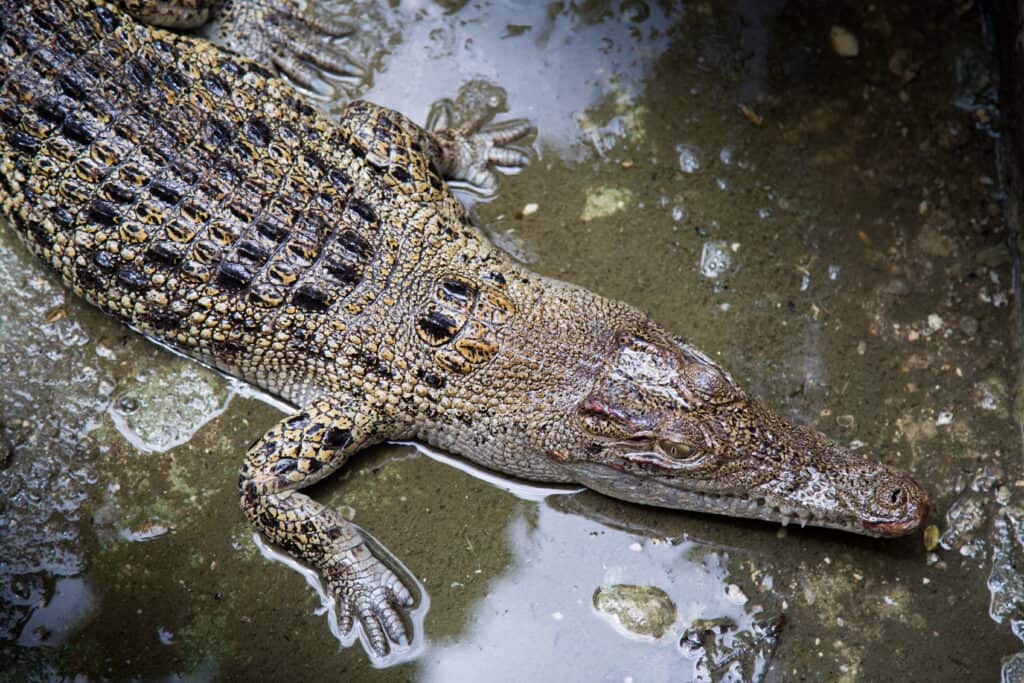
Philippine crocodiles tend to eat sickly fish rather than healthy ones, allowing the healthy ones to repopulate and increase.
©robert mcgillivray/Shutterstock.com
With its heavy, golden-brown armor, the Philippine crocodile may not be a very big type of crocodile, but it is still a sight to behold. This crocodile is endemic to the Philippines where it lives mostly in freshwater habitats. Unfortunately, it is also extremely endangered. In fact, the Philippine crocodile is the most critically endangered crocodile species in the world. In the past, these crocodiles lived all throughout the Philippines. Today, however, they only exist in Negros, Luzon, and Mindanao. Their populations are fragmented and isolated from one another, which makes it extra difficult to increase their numbers.
Philippine crocodiles are very helpful to the ecosystem, not only as apex predators keeping other species in check but also by promoting the growth of other healthy species. These crocodiles tend to eat sickly fish rather than healthy ones, allowing the healthy ones to repopulate and increase.
Strangely, the Philippine crocodile is often portrayed as a violent and dangerous man-eating animal, although the indigenous communities in the Philippines respect these relatively small crocodiles. Because of this misunderstanding, Philippine crocodiles are often hunted and killed even though they do not attack humans unless provoked. Fortunately, national laws now protect them, so hopefully, they will make a comeback in the future.
10. Nile Crocodile (Crocodylus niloticus)

Nile crocodiles typically live in freshwater habitats, although they can also inhabit brackish waters as well.
©David Havel/Shutterstock.com
Five crocodile species live in Africa, but the most common and infamous type of crocodile in the world is the Nile crocodile. This colossal croc is the second largest type of crocodile in the world (following closely behind the saltwater crocodile). Nile crocodiles typically live in freshwater habitats, although they can also inhabit brackish waters as well.
Nile crocodiles have dark bronze bodies with dark faded stripes and spots across their backs, though they may have different appearances based on where they live. Older crocs are usually darker in color. Nile crocodiles are large and sometimes look a bit lazy. They spend hours on end basking in the sun with their large jaws stretched wide open. However, don’t be fooled; these apex predators are always on alert and ready to ambush prey if an opportunity presents itself.
Nile crocodiles are Africa’s largest freshwater predators, with crocodiles on record that were over 20 feet long! However, most Nile crocodiles are closer to 9-14 ½ feet long. Like the gigantic saltwater crocodile, Nile crocodiles are also very aggressive animals that can effectively hunt just about any animal they come across. Nile crocodiles are one of the most dangerous types of crocodiles on earth, and according to the U.S. Geological Survey, between 2010 and 2014 these killer crocs attacked 480 humans in Africa.
11. West African Crocodile (Crocodylus suchus)

West African crocodiles are also known as desert crocodiles
©Anton Ivanov/Shutterstock.com
Found in West Africa and Central Africa, the West African crocodile is sometimes mistaken for a Nile crocodile. However, West African crocodiles are much smaller, growing between 5-8 feet on average, and have more slender snouts. Although West African crocodiles are much smaller and less aggressive than Nile crocodiles, they have been known to attack humans on occasion – but not nearly as much as Nile crocodiles do.
However, the Mauritanian traditional peoples in Africa work hard to protect these crocodiles and revere them as an essential element of the water in the area. There are even many small groups of West African crocodiles that live along the southern edge of the Sahara Desert! These “desert crocodiles” continue to astound scientists, as they live in caves, under rocks, and in burrows without permanent water sources for much of the year. To survive, these crocs go into a modified type of summer-like hibernation or torpor.
West African crocodiles once lived in the southern regions of the Nile River in Lower Egypt, where they were often selected by Ancient Egyptian priests for worship and mummification. People even kept them as pets, as they were smaller and less aggressive than Nile crocodiles in the area. The pool at Sobek’s temple, for example, held a crocodile that was worshiped and covered in gold and jewelry!
12. West African Slender-Snouted Crocodile (Mecistops cataphractus)

West African slender-snouted crocodiles are smaller crocs that grow between 10-13 feet long and weigh 275-715 pounds.
©iStock.com/GlobalP
Like its name, the critically endangered West African slender-snouted crocodile has a rather long and slender snout. This medium-sized crocodile uses its uniquely long snout like a handy pair of tweezers. This helps them to catch fish, crabs, frogs, and insects hiding in holes or crevices in freshwater habitats in West Africa. They can live in saltwater but prefer freshwater areas with dense vegetation. West African slender-snouted crocodiles are smaller crocs that grow between 10-13 feet long and weigh 275-715 pounds. Unfortunately, these crocodiles are extremely rare and on the verge of extinction.
West African slender-snouted crocodiles are surprisingly vocal. Male crocodiles make a very unique sound when competing with other males for mates. Allegedly it sounds like the bang a car makes when it backfires! Female crocodiles watch over their eggs for 110 days while they incubate. When baby crocodiles begin to hatch, they make high-pitched chirping sounds to call for their mother, who helps free them from their eggs. She continues to watch over them for the next two years or so while they grow and develop.
13. Central African Slender-Snouted Crocodile (Mecistops leptorhynchus)
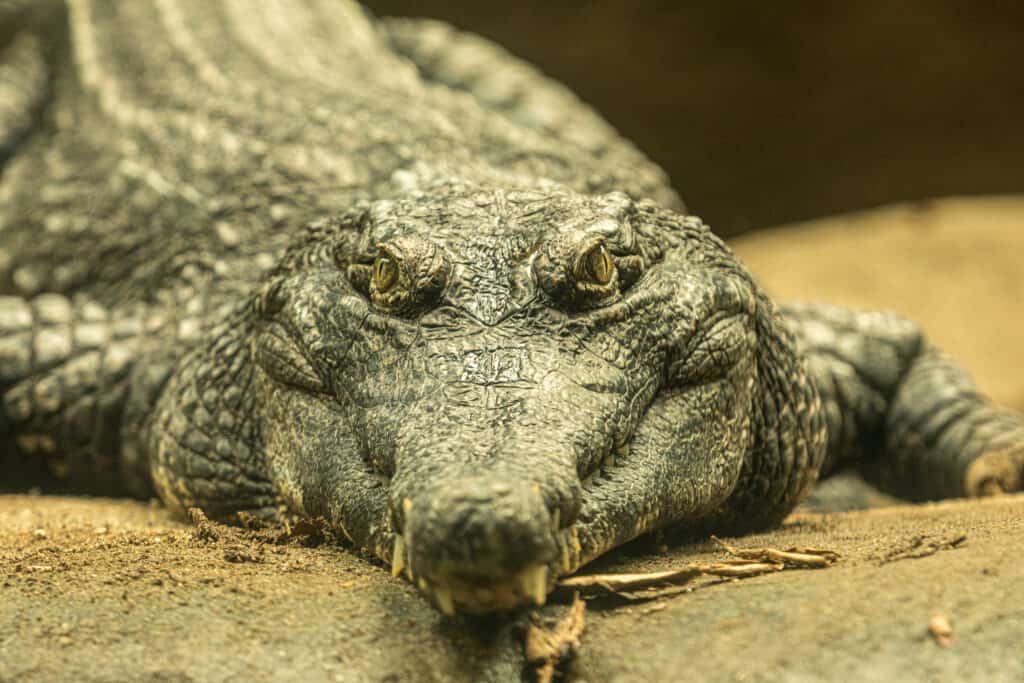
African Slender Snouted Crocodile lives in freshwater habitats in Central and West Africa. It can grow up to 13 feet long and 500 pounds.
©BrittanyO/Shutterstock.com
Although it looks a lot like its West African cousin, the Central African slender-snouted crocodile is a separate species. It typically has smoother skin than the West African slender-snouted crocodile, as well as a lighter jaw and less spotting. Like their name, Central African slender-snouted crocodiles live in Central Africa and small sections of East Africa. Unfortunately, the Central African slender-snouted crocodile is also critically endangered, and we do not know a lot about it. This type of crocodile lives in dense rainforests where it mostly eats fish. It usually grows between 10-13 feet in length and weighs between 275 and 715 pounds.
14. Dwarf Crocodile (Osteolaemus tetraspis)
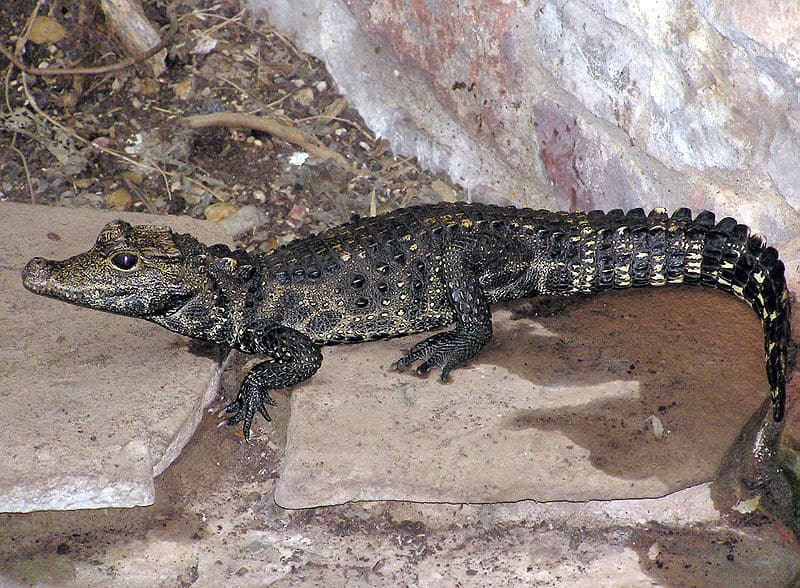
Although they are small, dwarf crocodiles are heavily armored for protection.
©Arpingstone, Public domain, via Wikimedia Commons – License
The smallest type of crocodile in the world is the dwarf crocodile in West Africa and Central Africa. This small croc only grows around 4.9-6.2 feet long and generally weighs 40-70 pounds. Dwarf crocodiles have dark backs and sides, with yellowish bellies covered in dark patches. However, an unusual phenomenon was recently discovered in the dwarf crocodiles of the caves of Abanda, Gabon. Not only have these unique crocodiles adapted to living in caves, but it turns out that they are bright orange! Thus far these caves are the only places where this strange coloration occurs.
Although they are small, dwarf crocodiles are heavily armored for protection. Since they are on the small side, they tend to avoid the larger sections of rivers. They instead prefer living in smaller rivers, streams, pools, swamps, and mangroves. Dwarf crocodiles are a shy and timid type of crocodile that is only occasionally active during the day. They spend most of the day hidden in burrows dug in the ground or small pools. Unfortunately, dwarf crocodiles are vulnerable to extinction, although many do live in protected animal reserves due to their small size and nonaggressive nature.
15. Osborn’s Dwarf Crocodile (Osteolaemus osborni)

Like other dwarf crocodiles, Osborne’s dwarf crocodile only grows around 4.9-6.2 feet long with a dark, heavily armored body.
©Marius Burger / CC0 1.0 – License
Although it has been known in the scientific world for more than 100 years, the Osborn’s dwarf crocodile was only recently accepted as its own separate and unique species. One of the smallest types of crocodiles in the world, the Osborn’s dwarf crocodile only lives in the Congo River Basin in Africa.
Like other dwarf crocodiles, Osborne’s dwarf crocodile only grows around 4.9-6.2 feet long with a dark, heavily armored body. This helps it camouflage in the small streams and pools it typically lives in. Although we do not know a lot about Osborn’s dwarf crocodiles, studies so far show that nearly half of their diet consists of crabs and gastropods, while the rest seems to be mostly fish and frogs. Unfortunately, due to habitat encroachment and hunting, these dwarf crocodiles are also vulnerable to extinction.
16. Cuban Crocodile (Crocodylus rhombifer)
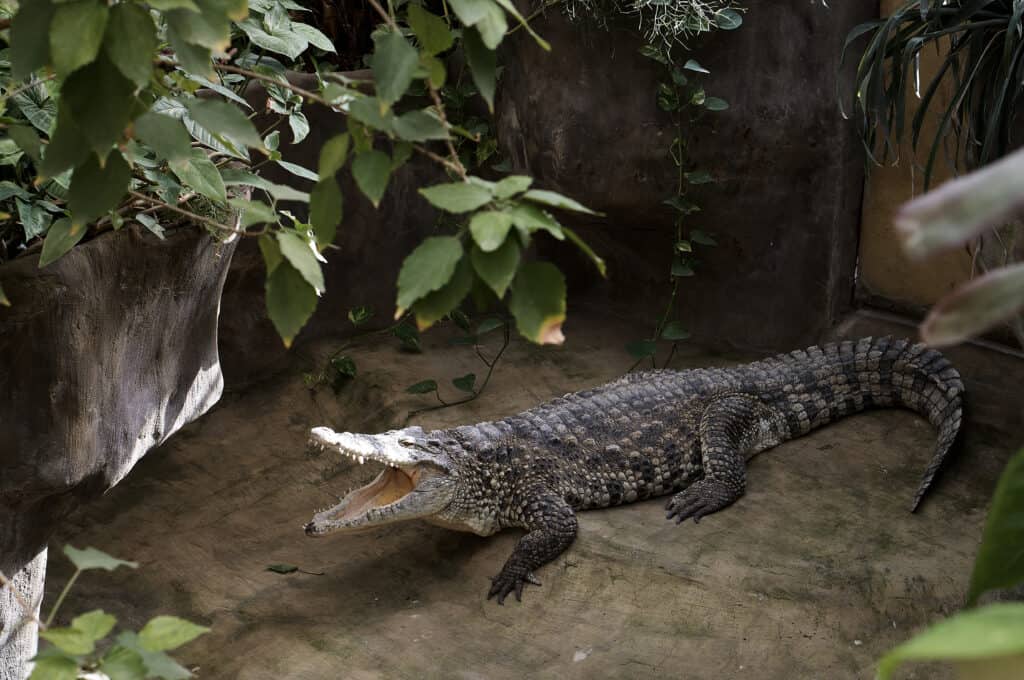
Although they historically lived throughout the Caribbean, Cuban crocodiles are a critically endangered species.
©iStock.com/Oleh Tiuriakov
They may be small, but Cuban crocodiles are definitely mighty! Cuban crocodiles are an extremely aggressive type of crocodile that lives only on Cuba’s Isla de la Juventud and the Zapata Swamp. Although they historically lived throughout the Caribbean, today Cuban crocodiles are a critically endangered species that have been aggressively hunted by humans. These crocs live in freshwater habitats like rivers, marshes, and swamps. While they can tolerate saltwater, they much prefer freshwater.
One of their most distinctive characteristics is that Cuban crocodiles are much brighter in color than most other croc species, with textured “pebbled” scales that give them a very unique look. Cuban crocodiles are usually 7-7.5 feet long and weigh 150-180 pounds. However, in very rare cases, they can grow up to 11 feet long.
Another rather unique trait of Cuban crocodiles is that these strange creatures are not lone hunters. Cuban crocodiles actually hunt in packs like wolves! They hunt both on land as well as in the water. Sometimes they even jump-feed and grab prey from branches that hang over their watery habitats. While their front teeth are sharp, they also have blunt teeth in the back of their mouths, which help them in crushing the shells of animals like turtles and crustaceans.
17. Orinoco Crocodile (Crocodylus intermedius)
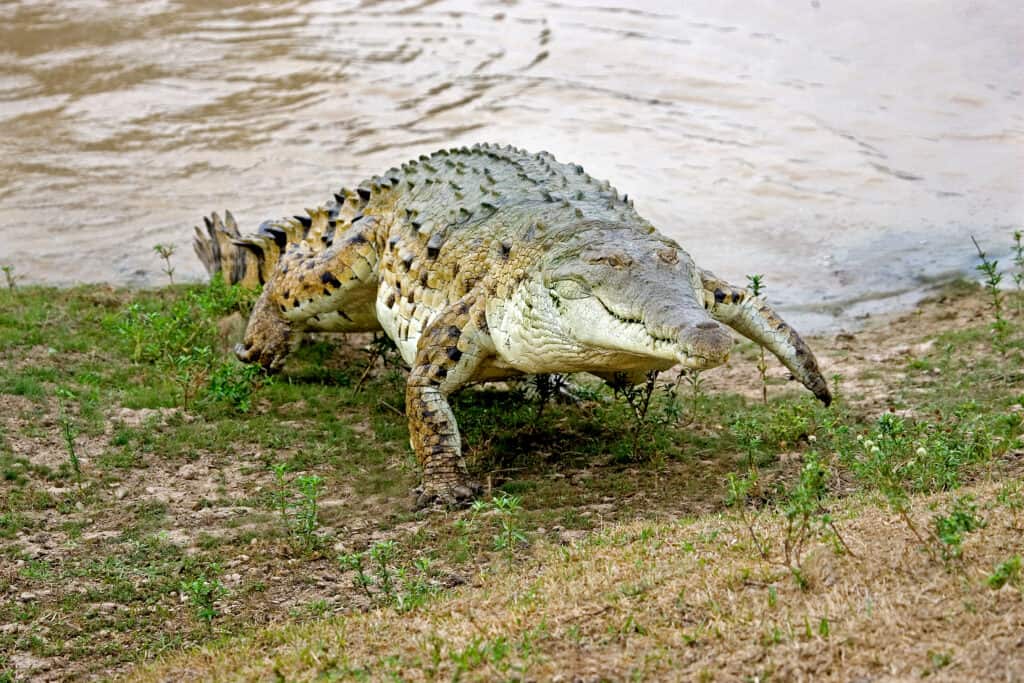
Orinoco Crocodile numbers significantly decreased over the past two centuries as they were hunted for their skins.
©slowmotiongli/Shutterstock.com
Another critically endangered species, the Orinoco crocodile lives only as a very small population in the Orinoco River Basin of Venezuela and Colombia. Its numbers significantly decreased over the past two centuries as they were hunted for their skins. So today it is one of the most endangered types of crocodile species in the world. Orinoco crocodiles live mainly in seasonal freshwater rivers where they mostly eat fish. Their uniquely elongated skull and snout design allow them to catch aquatic prey with ease, as it minimizes water resistance. While they mainly eat fish, they still hunt other animals that come their way, such as deer, monkeys, domestic animals, invertebrates, birds, and other reptiles.
Orinoco crocodiles are usually a pale tan, completely yellowish, or a dark brownish-gray color, and they can change color as the amount of melanin in their skin changes. They have dark banded markings when they are young, but as they mature these dark patterns become more scattered throughout their bodies. Females usually grow around 8 feet long and males grow around 9 feet long. However, before severe overhunting for their skins, Orinoco crocodiles were recorded reaching 13-16 feet long and weighing 840-1,430 pounds!
18. Morelet’s Crocodile (Crocodylus moreletii)

Morelet’s crocodiles are a dark grayish-brown color with broad snouts and dark spots and banded patterns.
©iStock.com/slowmotiongli
Last but certainly not least is the Morelet’s crocodile, found in Guatemala, Belize, and Mexico. These crocs prefer freshwater habitats that are isolated and secluded, like inland marshes, swamps, large rivers, and lakes with forests and dense cover. However, they often spread out during floods and rainy seasons, and can sometimes be found in brackish waters along the coast of the Yucatán Peninsula and in grassy savanna habitats.
Morelet’s crocodiles are a dark grayish-brown color with broad snouts and dark spots and banded patterns. Younger crocodiles also have dark bands, but their bodies are bright yellow. On average males grow around 6-7 feet long and weigh 150-259 pounds, although large males may grow upwards of 10 feet in length in rare cases. They have a similar appearance to the American crocodile, but their skin is a bit darker. Like other crocodile species, Morelet’s crocodiles are opportunistic eaters and will hunt just about anything they can catch, from small mammals to reptiles, birds, fish, crustaceans, and even domestic animals like large dogs and cats.
Crocodile Lifespan
Smaller species of crocodile have a life expectancy of about 30-40 years in the wild. Larger examples of these creatures, such as the Saltwater crocodile, can live considerably longer. Many specimens of this species have been recorded as living up to 80-100 years old!
Crocodiles are also some of the most ancient animals on the planet, with some recently discovered fossils dating back to 185 million years ago. Crocodiles make appearances in many artifacts uncovered from humankind’s earliest civilizations, oftentimes appearing as companions to deities or as the embodiments of the divine themselves.
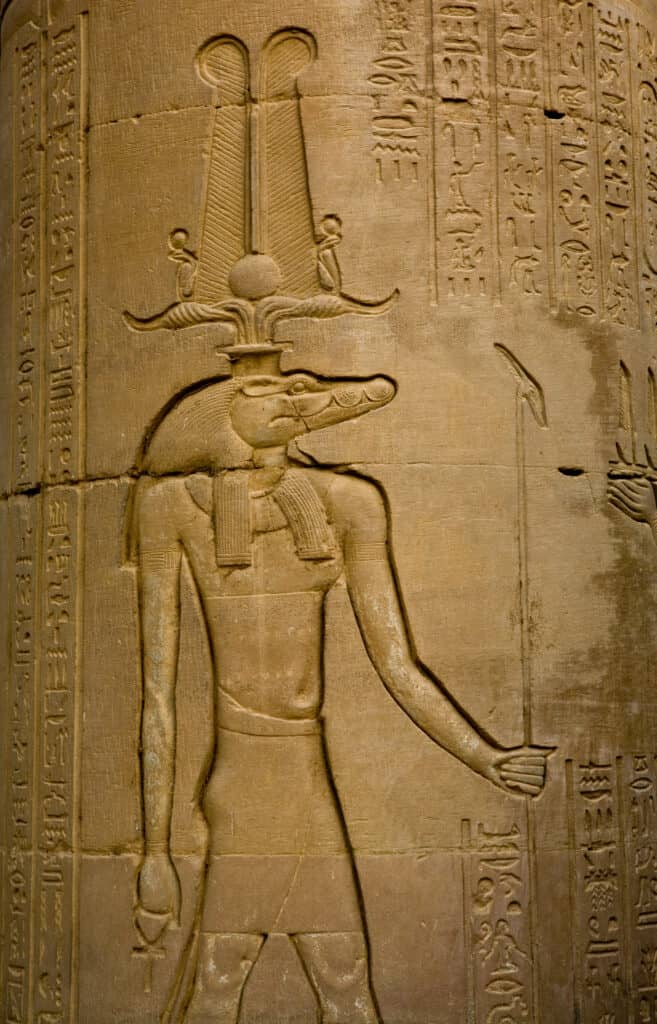
Sobek was a god of ancient Egypt depicted with a human body and crocodile head.
©iStock.com/WHPics
Summary of All 18 Types of Crocodiles Found Across the World
Here’s a recap of the 18 type of crocodiles around the globe that we took a close look at:
| Species | Length | Range |
|---|---|---|
| American Crocodile | 9-14 feet long | United States, Caribbean |
| New Guinea Crocodile | 9-11 feet long | New Guinea |
| Hall’s New Guinea Crocodile | 9-11 feet long | New Guinea |
| Freshwater Crocodile | 7-9.8 feet long | Australia |
| Saltwater Crocodile | 11-19 feet long | Australia |
| Borneo Crocodile | NA | Borneo |
| Siamese Crocodile | 7-10 feet long | Southeast Asia |
| Mugger Crocodile | 6.5-11.5 feet long | Indian subcontinent & surrounding areas |
| Philippine Crocodile | 5-9 feet long | Philippines |
| Nile Crocodile | 9-14.5 feet long | Africa |
| West African Crocodile | 5-8 feet long | West Africa |
| West African Slender-Snouted Crocodile | 10-13 feet long | West Africa |
| Dwarf Crocodile | 4.9-6.2 feet long | West Africa |
| Osborn’s Dwarf Crocodile | 4.9-6.2 feet long | West Africa |
| Central Africa Slender-Snouted Crocodile | 10-13 feet long | Central Africa, East Africa |
| Cuban Crocodile | 7-7.5 feet long | Cuba |
| Morelet’s Crocodile | 4.9-8.8 feet long | Mexico, Belize, Guatemala |
| Orinoco Crocodile | 8-10 feet long | Colombia, Venezuela |
The photo featured at the top of this post is © BrittanyO/Shutterstock.com
Sources
- , Available here: https://www.iucncsg.org/365_docs/attachments/protarea/21%20O-c1d8ab26.pdf
- , Available here: https://news.mongabay.com/2020/07/from-new-guinea-to-florida-one-of-these-crocs-is-not-like-the-others/
- , Available here: https://www.cnn.com/2019/09/25/world/new-crocodile-species-scn/index.html
- , Available here: https://www.dcceew.gov.au/sites/default/files/env/pages/dc11235d-8b3b-43f7-b991-8429f477a1d4/files/40-fauna-2a-crocodylia-morphology.pdf
- , Available here: http://biostor.org/reference/69031
- , Available here: https://www.marylandzoo.org/animal/african-slender-snouted-crocodile/
- , Available here: https://www.oregonzoo.org/discover/animals/african-slender-snouted-crocodile
- , Available here: https://www.researchgate.net/publication/235800476_A_new_future_for_the_Philippine_crocodile_Crocodylus_mindorensis
- , Available here: https://reptile-database.reptarium.cz/species?genus=Mecistops&species=leptorhynchus
Thank you for reading! Have some feedback for us? Contact the AZ Animals editorial team.




